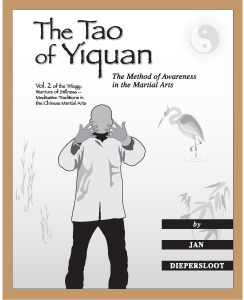
For sale by Amazon and other booksellers
The Tao of Yiquan - The Method of Awareness in the Martial Arts
Summary: This is the 2nd volume of the Warriors of Stillness series on the meditative traditions in the Chinese martial arts. The book has four parts.
In Part 1, I trace the historical connection of the Yiquan health and martial arts system back to the introduction of Buddhism and its practices into Chinese culture in the period of 0- 500 CE, and traces its subsequent development through Chinese history up to the 20th century.
In Part 2, I detail the life and writings of the 20th century inheritor of this ancient lineage and the modern day founder of Yiquan, Grandmaster Wang Xiangzhai
In Part 3, I describe my experiences while studying Yiquan with different Yiquan masters, several of whom were the top students of Wang Xiangzhai. Most unique of the Yiquan training methods is the practice of stillness in standing meditation to produce a special type of integration of body and mind that enables the production of fa jin, a deadly explosive force.
In Part 4, I describe the other (yin) side of the coin of Yiquan: the only way to counter and control the deadly force of fa jin is the yielding capacity of awareness. I describe and illustrate how on the highest levels of martial achievement, Yiquan training develops the neuro-sensory skills of awareness to defeat neuro-muscular skills of speed and power.
Table of Contents:
PART I BUDDHISM AND MARTIAL ARTS IN ANCIENT ASIA
Chapter 1 Bhuddism and Martial Arts in Ancient India
1. Pre-Buddhist India 3
2. Buddha's Childhood Training 7
3. Buddhism and Indian History 9
4. Buddhism and Martial Arts 10
Chapter 2 Buddhism and Martial Arts in Ancient China
1. Buddhism in Ancient China 13
2. Bodhidharma : 520 AD 17
3. Tang Dynasty (600-900 AD): Martial Art As Spiritual Quest 22
Chapter 3 The Secularization of Buddhist Martial Arts
1. Song Dynasty 27
2. Shaolin Ethical Legacy 30
3. Yueh Fei and Hsingyiquan 32
4. Buddhism, Taoism and the Creation of Hsingyiquan 34
5. Yuan and Ming Dynasties(1271-1644) 39
6. Qing Dynasty (1644-1912) 40
7. Guo Yunshen's Summary of Hsingyiquan 42
PART II THE GENIUS OF WANG XIANGZHAI
Note and Caveat 51
Chapter 4 The Life of Wang Xiangzhai
1. The Apprenticeship 53
2. Early 1900's: The Quest 57
3. Shoalin Monastery 60
4. Wang Xiangzhai and Dunhuang 63
5. Naming the Art 68
6. The 1930s: Domestic & Foreign Challenges 70
7. The 1940s: Beijing and Dachengquan 73
Chapter 5 Wang Xiangzhai's Writings
1. Introduction 81
Historical origins 81
Criticism of normal exercise 83
Standing as preferred exercise 84
2. Zhanzhuang -Pile Standing 86
Unification is simplification 86
Conducting internal investigations 87
Promoting energy flow through non-exertion 88
Movement and stillness 88
Polarity as a tool of enlightenment 89
3. Shili -Building Strength 91
Sources of strength 91
Stretching 92
Integration 93
4. Fali -Using Strength 95
5. Radical Criticisms
Hsingyiquan 97
Taijiquan 98
Baguazhang 99
PART III THE TAO (YANG) OF YIQUAN
Chapter 6 Zhanzhuang & the Structure of Stillness
1. Master Han Comes to America 103
2. Practice with Master Han 104
3. Therapeutic Discoveries 108
4. Pile Standing 110
5. Centerline 111
6. Centerpoint 112
7. Activating the Torso Spring 113
8. Foundation 115
9. Sphere 116
10. Nervous System Integration 117
Chapter 7 Polarity & the Grammar of Movement
1. Introduction 119
2. Vertical CL Movement 120
3. Horizontal CL Movement 123
4. Rotational CL Movement 125
5. Functional Stances 126
6. Walking 127
7. Turning 131
8. Movements of the Sphere 133
a. extendion-retraction 134
b. onversion-eversion 135
c. up-down 136
d. opening-closing 139
Chapter 8 Building Strength with Awareness
1. Discovering the Pulse of Life 145
2. Breathing for Relaxation and Strength 148
3. Pulse Energy Exercises 150
4. Wave Energy Exercises 154
5. Further Wave Exercises 157
6. Spiral Energy Exercises 161
7. Functional Stances & Movement Exercises 166
8. Walking Movement Exercises 170
9. The Use of Sound 178
Chapter 9 Using Strength with Awareness
1. The Internalization of Movement 181
2. Awareness Exercises 182
3. Internal Isometrics 182
4. Discharging Energ 184
5. Partnered Work with Professor Yu 186
6. Master Cai and the Refinement of Jin 190
PART IV THE TAO (YIN) OF YIQUAN
Chapter 10 Yiquan and Taijiquan
1. Polarity of Pengjin 197
2. Wang Xiangzhai and Tajiquan 198
3. Yu Pengxi and Empty Force 201
4. The Genesis of Empty Force 203
5. Empty Force as a Game of Awareness 205
6. The Limitations of Empty Force 207
Chapter 11 Stillness and Movement with Master Tam
1. Meeting Sam Tam 211
2. Sam Tam and Taijiquan 212
3. The Spine and the Centerline 215
4. Structure of the Sphere 217
5. The Foundation of the Legs 219
6. Circular Movement 221
Chapter 12 MasterTam and the Practice of No- Force
1. Using Force 223
2. Using No Force 224
3. Using Attention 229
4. Using Intention 230
5. Sticking 232
6. Mind Games 234
7. Pattern Practice 236
Afterword 241
Notes 245
Index 253
